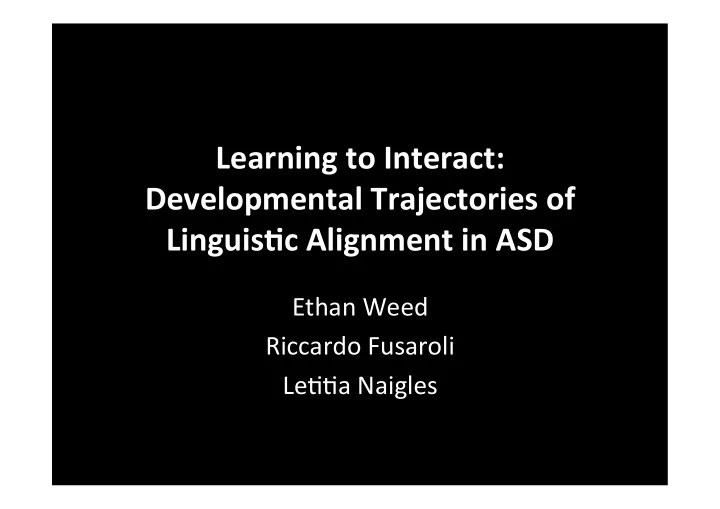

Learning to Interact: Developmental Trajectories of Linguis8c Alignment in ASD Ethan Weed Riccardo Fusaroli Le44a Naigles
A conversa4onal phenomenon Did you put your baby to sleep ? Yeah She’s sleeping Looks like she fell off her bed Don't fall off the bed
What to call this phenomenon? • “Linguis4c recycling” (Perkins, 2004) • “Interac4ve alignment” (Pickering & Garrod, 2004) • Priming
Interac4ve Alignment
Linguis4c recycling
Alignment in systems • Combina4on of: – External forces – Internal mechanisms • “Why is conversa4on so easy?” (Garrod & Pickering, 2004)
A horse is pulling a woman • Branigan & McLean (2016) • TD children (N = 32, ages 3.5 - 4) are influenced by syntac4c priming
The pirate shows the clown a gun • Slocombe et al (2013) • Adults with Asperger’s syndrome (N = 17, ages 18-51) are influenced by syntac4c priming
The witch was dragged by the bear Allen et al (2011) • Children with ASD (N = 12, ages 8-12) are influenced by syntac4c priming just like TD controls
The sheep kissed the queen Hopkins et al (2016) • Children with ASD (N = 17, ages 8 - 14) are influenced by syntac4c priming just like TD controls
Conversa4on is hard for kids with ASD Hopkins et al (2016) • What about natural conversa4on?
What pet is the best? Hopkins et al (2016)
Research ques4ons 1. Does the degree of interac4ve alignment change as children age?
Research ques4ons 1. Does the degree of interac4ve alignment change as children age? 2. Is the degree of interac4ve alignment different in children with au4sm?
Conversa4onal alignment in au4sm • Previous studies have found no difference in conversa4onal alignment between individuals with ASD and controls in task-oriented conversa4ons – Allen et al, 2011; Hopkins et al, 2014; Slocombe et al 2014; Branigan et al 2016. • But studies of non –verbal alignment found decreased alignment in postural sway and other non-task related movements
Study details • 32 children with ASD • 35 TD children • Star4ng at approx 1 year • Ini4ally language-matched 6 visits over 3 years (ca. 400 videos) • 30 minutes of play • Full transcrip4on at word-level
How did we define alignment? • Lexical: probability of repea4ng caregiver’s words in the following speech turn controlling for uierance length (cosine similarity). • Syntac4c: probability of re-using caregiver’s parts of speech in the following speech turn controlling for uierance length (cosine similarity) and removing lexical alignment. • N.B. we exclude lack of engagement (no answer).
How did we model alignment? • Mixed-effects growth curve models • Fixed factors: – ASD diagnosis (0, 1) – Visit – Gender – Mullen score – ADOS score (only for ASD) • Random effects: – Visit (linear and quadra4c) over Child
Results: Lexical alignment
Results: Syntac4c alignment
Research ques4ons • Does the degree of interac4ve alignment change as children age? • Is the degree of interac4ve alignment different in children with au4sm?
Research ques4ons • Does the degree of interac4ve alignment change as children age? – Yes
Linear and quadra4c components to alignment development • Lexical linear: β=0.76, SE=0.2, t- stat=3.88, p=0.0001 • Lexical quadra4c: β=-0.56, SE=0.18, t-stat=- 3.07, p=0.002 • Syntac4c linear: β=1.12, SE=0.44, t-stat=2.53, p=0.011 • Syntac4c quadra4c: β=-0.95, SE= 0.45, t-stat=- 2.12, p=0.034
Research ques4ons • Does the degree of interac4ve alignment change as children age? – Yes • Is the degree of interac4ve alignment different in children with au4sm?
Research ques4ons • Does the degree of interac4ve alignment change as children age? – Yes • Is the degree of interac4ve alignment different in children with au4sm? – Yes
Lower degree of alignment in children with ASD (+ ADOS) • Lexical: β=-0.01, SE=0.01, t-stat=-1.96, p=0.05 • Syntac4c: ASD: β=-0.07, SE=0.04, t-stat=-2, p=0.045 • Higher ADOS is related to lower lexical (β=-0.13, SE=0.05, t-stat=-2.6, p= 0.01) • Higher ADOS is related to lower syntac4c alignment (β=-0.09, SE= 0.04, t-stat=-2.47 p=0.013)
Other factors • Higher Mullen is related to higher lexical (β=0.01, SE=0.01, t-stat=1.94, p=0.05) and lower syntac4c alignment (β=-1.16, SE=0.33, t- stat=-3.48, p<0.0001) • No effects of gender • No interac4on with 4me
Why do we see a difference in alignment? • Possible factors – Free conversa4on* – Younger children – Greater range of symptom severity • * but see Hopkins et al (2016)
Ques4ons for the future • What do different levels of alignment reflect? • Is it always “good” to align? • Do caregivers align differently to ASD and TD children? • What about “conceptual alignment” which is not captured by our analysis?
Thank you • Linguis4c Data Consor4um • Julia Parish-Morris • Leila Bateman
Recommend
More recommend